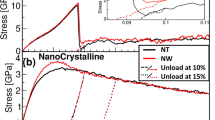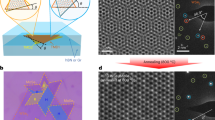Abstract
This article introduces a novel nanomechanical architecture to form pure metallic nanotubes or nanocoils via spontaneous self-rolling of initial planar free-standing bilayer thin films. Our molecular dynamics simulation results show that if the film is only a few nanometers thick, the spontaneous reorientation of the (001) top layer leads to rolling-up of the initially planar, free-standing, (001)/(111) bilayer into a tubular or coiled structure. The driving force for this process is given by the existence of an initial mismatch strain between the 2-nm-thick layers of different textures. Our detailed analysis of the reorientation process indicates that the bilayer self-rolling is determined by both energetic and kinetic processes characterizing the spontaneous structural reorientation of the top (001) textured layer to the (111) orientation of the substrate layer. Specifically, the analysis of the simulation results indicates that reorientation of the (001) top layer proceeds via a mechanism characterized by nucleation from multiple sites, propagation, and growth of the new (111)-oriented domains embedded in the original (001)-oriented layer. While individually the newly formed (111) domains grow free of defects, a region containing a surface dislocation-like linear defect forms at the boundary where two such domains meet. The equilibrium of the newly formed bilayer structure containing the surface dislocations is attained by multiple localized bendings of the bilayer structure about the direction coinciding with the dislocations line (the \( [\bar{1}10] \) direction). The spacing (density) of the nucleation is a function of temperature and influence the radius of curvature of the resulting structure.









Similar content being viewed by others
References
Z.W. Pan, Z.R. Dai, and Z.L. Wang, Science 291, 1947 (2001).
C.M. Lieber and Z.L. Wang, MRS Bull. 32, 99 (2007).
V.Y. Prinz, V.A. Seleznev, A.K. Gutakovsky, A.V. Chehovsky, V.V. Preobrazhenskii, M.A. Putyato, and T.A. Gavrilova, Physica E 6, 828 (2000).
S.V. Golod, V.Y. Prinz, P. Wagli, L. Zhang, O. Kirfel, E. Deckhardt, F. Glaus, C. David, and D. Grutzmacher, Appl. Phys. Lett. 84, 3391 (2004).
O.G. Schmidt and K. Eberl, Nature 410, 168 (2001).
O. Schumacher, S. Mendach, H. Welsch, A. Schramm, C. Heyn, and W. Hansen, Appl. Phys. Lett. 86, 143109 (2005).
J. Zhang and F. Liu, Nanotechnology 18, 405501 (2007).
M. Huang, C. Boone, M. Roberts, D.E. Savage, M.G. Lagally, N. Shaji, H. Qin, R. Blick, J.A. Nairn, and F. Liu, Adv. Mater. 17, 2860 (2005).
J. Zhang, M. Huang, and F. Liu, Phys. Rev. Lett. 98, 146102 (2007).
J. Lao and D. Moldovan, Appl. Phys. Lett. 93, 093108 (2008).
Y. Kondo, Q. Ru, and K. Takayanagi, Phys. Rev. Lett. 82, 751 (1999).
A. Hasmy and E. Medina, Phys. Rev. Lett. 88, 096103 (2001).
Y. Mishin, D. Farkas, M.J. Mehl, and D.A. Papaconstantopoulos, Phys. Rev. B 59, 3393 (1999).
T. Wagner, J. Marien, and G. Duscher, Thin Solid Films 398, 419 (2001).
G.H. Kim and C.I. Kim, Thin Solid Films 515, 4955 (2007).
Acknowledgements
This work was supported in part by NSF-EPSCoR through Grants EPS-0701491 and EPS-0346411. The simulations were performed at the LSU Center for Computation & Technology and LONI Supercomputer Center.
Author information
Authors and Affiliations
Corresponding author
Rights and permissions
About this article
Cite this article
Lao, J., Moldovan, D. Formation of Nanotubes and Nanocoils by Spontaneous Self-Rolling of Aluminum (001)/(111) Bilayer. JOM 65, 168–174 (2013). https://doi.org/10.1007/s11837-012-0507-x
Received:
Accepted:
Published:
Issue Date:
DOI: https://doi.org/10.1007/s11837-012-0507-x




